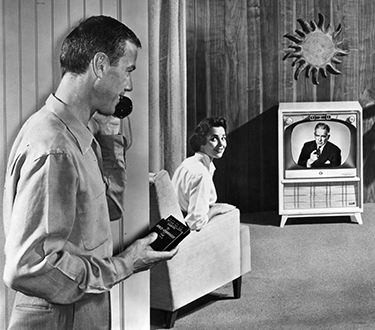Since CTA’s start in 1924 as the Radio Manufacturers Association, U.S. technology companies have had an advocate on Capitol Hill and across the country for innovation and free enterprise. As the competitive and regulatory climate has changed, so has our association. Find out in this five-part series how CTA has led industry growth and supported technology innovations that are solving big global challenges. This article, the series second, tells the CTA story from 1950 to 1979.
If you were born in the U.S. before about 1945, iconic TV of the 1950s probably left a lasting impression. The huge, console-style television sets of the day were a must-have in the modern home as families gathered to consume appointment TV that included many titles still available on streaming networks. Among them: I Love Lucy, Rod Serling’s Twilight Zone, Dragnet, Gunsmoke and Leave It to Beaver.
While the American middle class was captivated by the emerging medium’s programs and stars, society was becoming more polarized, politically and culturally. From the 1950s through the 1970s, daily life was altered by events that included the Korean War, the Warsaw Pact, the Vietnam War, the Civil Rights Movement, the Gay Liberation Movement, Woodstock and the Watergate scandal. Each of these transformational milestones – and many, many more - deeply shook traditionalist norms. Those years were also pivotal for CTA as the association contended with impacts to its constituency caused by post-WWII economics and politics, the advent of TV and early computing. Here’s how those years unfolded for CTA and the industry.
1950-1951: Introducing the Radio-Television Manufacturers Association (RTMA)
As television adoption exploded, the association restructured to embrace changes and tech industry trends. In 1950, the Radio Manufacturers Association (RMA) rebranded as the Radio-Television Manufacturers Association (RTMA). The organization also raised membership dues and added a salary for its president. In 1951, Glen McDaniel became the first president with a salary.
1950s: War in Korea and Manufacturing Challenges
With the Korean War threatening crucial supplies of essential materials for radio and television manufacturing, RTMA worked to organize information for members about navigating these shortages and identifying potential alternative materials to make up for the deficits.
1952: Creation of the Medal of Honor Award
The award was created to recognize and celebrate the contributions of those whose work furthered the domestic electronics industry. The list of recipients included members whose individual companies read like a who’s who of American electronics success. Among the honorees were IBM, HP, Motorola, Texas Instruments, General Electric, Raytheon and RCA.
1953 and 1957: From RTMA to RETMA, then EIA

A promotional photo for member company Zenith in 1956 when it released the Zenith Space Commander 400, one of the first remote television controllers. The ultrasonic remote required no cords or batteries and remained popular until infrared technology was introduced to remote controls in the 1980s. Source: Getty Images.
Recognizing the changing face of American industry and wanting to incorporate the word “electric” into its name to better represent its work, RTMA became Radio-Electronics-Television Manufacturers Association (RETMA) in 1953. Then, in 1957, members looked to the future with a new name, the Electronics Industry Association (EIA), one that underscored an expansion beyond radio and television, embracing all industry segments of electronics.
1967: The First CES Opens in New York
Highly successful from the outset, the first Consumer Electronics Show – CES – was held in New York June 25-28. Organized by Staff Vice President Jack Wayman, it occupied more than 100,000 square feet in the Hilton and Americana hotels, attracting more than 100 exhibitors and 17,000 attendees. Among the highlights were exhibits displaying pocket radios and TVs with integrated circuits. The kickoff speaker was Motorola Chairman Bob Galvin.
Key takeaway from the CTA Television ERA: Electronics innovation of the time defied the imagination, as evidenced by the inaugural CES’s success. Tech industry leaps and bounds prompted the association’s brand updates and signaled recognition of groundbreaking developments across its membership. Find out how consumer-focused technology, which dominated retail markets from 1980 to 1994, impacted the association and industry landscape. It’s all in the third article of this series, Igniting Innovation Since 1924: Consumer Tech Takes Off. To learn more about CTA’s start, check out the first article in the series, Igniting Innovation Since 1924: The Radio Era.